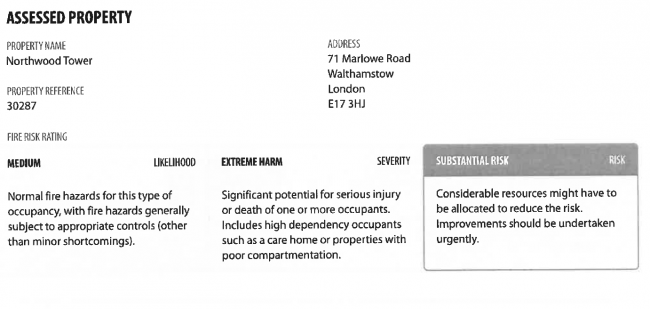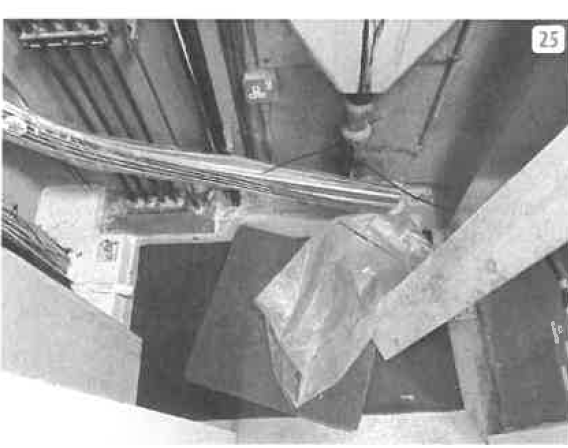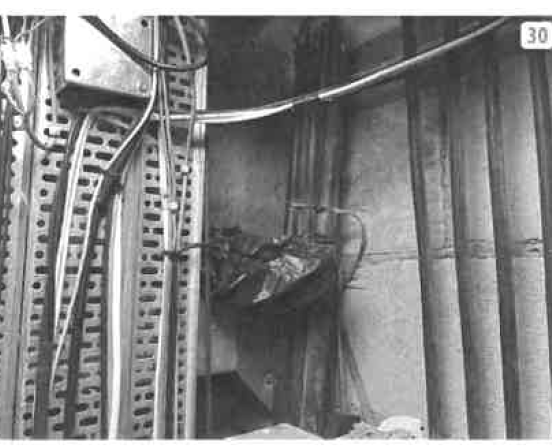LBWF and fire hazards in its housing stock: the appalling case of Northwood Tower in Walthamstow (1)
In the past few months, journalists James Cracknell and Michelle Edwards of the Waltham Forest Echo have done sterling work in exposing the serious safety flaws that currently blight many of the 22 tower blocks in the borough, see here
https://walthamforestecho.co.uk/fire-safety-flaws-at-borough-tower-blocks/
here
https://walthamforestecho.co.uk/tower-residents-fire-safety-fears/
and here
https://walthamforestecho.co.uk/returning-to-northwood-tower/
What follows examines one of the tower blocks in detail, documents the dreadful situation that pertained there as of mid-2018, and reveals that many of the flaws then existent also had been clearly identified several times previously, indeed included in remedial action plans, but then inexplicably left unaddressed.
Northwood Tower in Marlowe Rd., Walthamstow, has 99 flats spread over 21 floors, and is home to c. 300 people.
It is owned by Waltham Forest Homes, in other words, the council, and because identified as ‘a high priority property’, has to be risk assessed for fire every year, with the current assessor being the experienced and qualified Ridge and Partners LLP (hereafter Ridge).
In its most recent assessment report, completed at the end of June 2018, Ridge came to the following general conclusion:
 This was based upon the examination of 106 separate metrics, 65 of which were said to require ‘remedial action’.
This was based upon the examination of 106 separate metrics, 65 of which were said to require ‘remedial action’.
Some of Ridge’s most notable and worrying findings were as follows:
| Control of Sources of Ignition | |
| Are visible electrical installations in good condition? | NO |
| Control of Sources of Fuel | |
| Is there a system in place for the regular collection and disposal of rubbish and combustible waste? | NO |
| Are refuse chutes adequately maintained and with adequate fire resistance? | NO |
| Compartmentation | |
| Are there sufficient facilities for the control of smoke installed within the building? | NO |
| Is the building adequately compartmentalised for the purpose of containing smoke and flame? | NO |
| Do flat fire doors provide adequate fire resistance and appropriate ironmongery? | NO |
| Do electrical/service and cupboard doors have adequate fire resistance and appropriate ironmongery/signage? | NO |
| Do communal fire doors have adequate fire resistance and appropriate ironmongery/signage? | NO |
| Measures to Assist the Fire Service | |
| Does the Fire Service information box contain sufficient documentation/information (eg. Building plans, PEEPs and/or office keys)? | NO |
| Fire Procedures and Training | |
| Is there an effective emergency plan for the premises which is appropriately communicated to building users? | NO |
| Means of Escape | |
| Are final exits sufficient in number, size and type and do they lead to a place of safety? | NO |
| Do lifts have ‘Do not use lift in event of fire’ signage? | NO |
Ridge also included some fairly startling photographs, such as these, which show debris in unlocked riser cupboards, reportedly to be found on floors 1,3, 4,8,10, 11, 12, 15 and 20:
Ridge concluded its report with an action plan itemising the 65 issues requiring remediation, with 21 said to be ‘long term’, 36 ‘medium term’ and eight ‘short term’.
Some of the latter were wide-ranging and very critical, for example this:
Such findings are of course shocking.
But there is worse, because a little digging reveals that, though not all the Ridge annual reports are available, many of exactly the same flaws also had been noted previously, going back to at least mid-2014:
| Ridge report date | 2018-19 | 2015-16 | 2014-15 |
| Control of Sources of Ignition | |||
| Are visible electrical installations in good condition? | NO | NO | NO |
| Control of Sources of Fuel | |||
| Is there a system in place for the regular collection and disposal of rubbish and combustible waste? | NO | NO | YES |
| Are refuse chutes adequately maintained and with adequate fire resistance? | NO | NO | NO |
| Compartmentation | |||
| Are there sufficient facilities for the control of smoke installed within the building? | NO | YES | YES |
| Is the building adequately compartmentalised for the purpose of containing smoke and flame? | NO | NO | YES |
| Do flat fire doors provide adequate fire resistance and appropriate ironmongery? | NO | NO | NO |
| Do electrical/service and cupboard doors have adequate fire resistance and appropriate ironmongery/signage? | NO | NO | NO |
| Do communal fire doors have adequate fire resistance and appropriate ironmongery? | NO | NO | NO |
| Measures to Assist the Fire Service | |||
| Does the Fire Service information box contain sufficient documentation/information (eg. Building plans, PEEPs and/or office keys)? | NO | NA* | NA* |
| Fire Procedures and Training | |||
| Is there an effective emergency plan for the premises which is appropriately communicated to building users? | NO | NO | NO |
| Means of Escape | |||
| Are final exits sufficient in number, size and type and do they lead to a place of safety? | NO | YES | YES |
| Do lifts have ‘Do not use lift in event of fire’ signage? | NO | NO | YES |
(NA* – Noted that Fire Service information box not required. However, also noted that ‘fire log books and records’ were not suitable and sufficient’)
It is almost beyond belief that, despite Ridge’s warnings, such important matters remained wholly disregarded. What is the point of having annual assessments if their recommendations are ignored?
Responding to the Waltham Forest Echo revelations, LBWF issued a PR release which claimed sprinklers were being introduced into tower blocks, and ended with the cliche ‘The safety of our tenants is the top priority and we do all we can to ensure it’.
For her part, and as a near neighbour, Ms. Edwards sees little change at Northwood Tower, and believes residents are still living in a ‘death trap’.
Arguments about the here and now will doubtless continue.
But the facts rehearsed in this post concerning 2014-18 are incontrovertible.
LBWF’s chosen assessor, Ridge, regularly reported that Northwood Tower was riddled with serious fire hazards.
Yet little remedial action followed, and tellingly the building was very probably in a more dangerous condition at the end of the period than it had been at the beginning.
LBWF Chief Executive Martin Esom earns £200,000 per year, £50,000 more than the Prime Minister, and holds ultimate responsibility for all council operations in the borough.
As Leader, Cllr. Clare Coghill is Mr. Esom’s employer.
It is my belief that, confronted with the total failure that has been described here, which put many residents in active and present danger for a prolonged period of time, both should now immediately resign.



